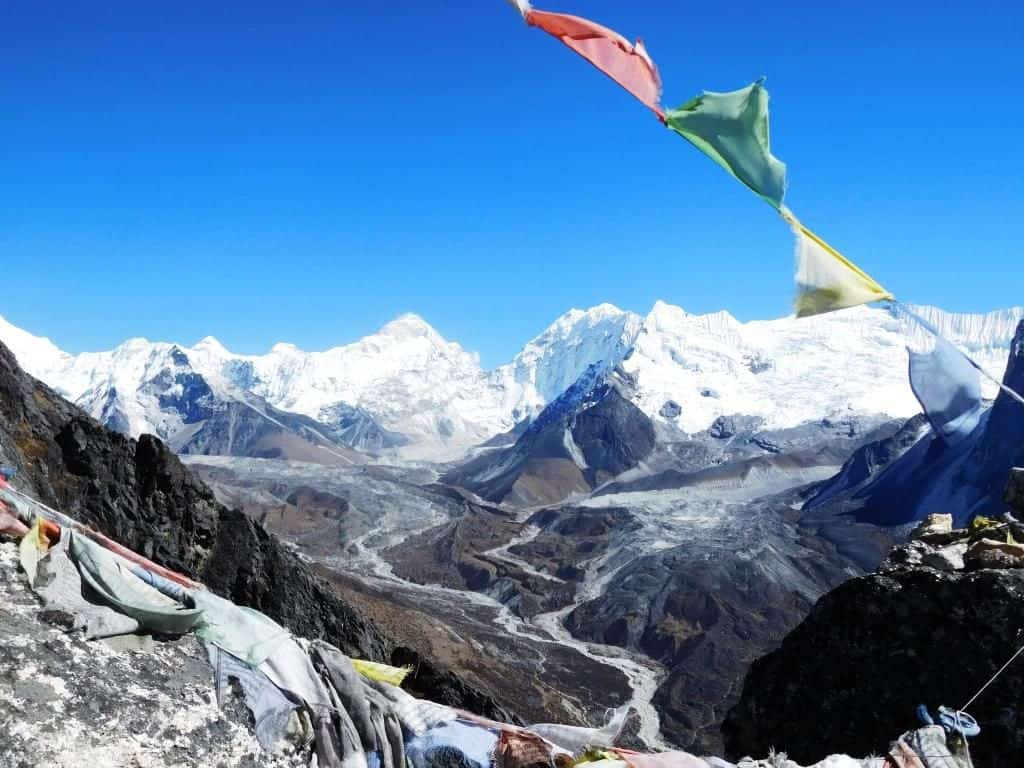Once you reach Pangboche you are definitely out of the trees and the vista changes utterly. The absence of softening vegetation makes the panorama seem larger and harsher – and of course the colours change. You start to see lots more snow and ice, as well as vast shiny grey scree slopes as the Himalayas catapult downwards under their own steepness. In places huge mountainsides have simply cleaved and fallen off, sometimes damming vast ice rivers and forming beautiful turqoise lakes.

Even along the river it is barren lands.

View from Nangartschang Hill of one such cataclysmic lake.
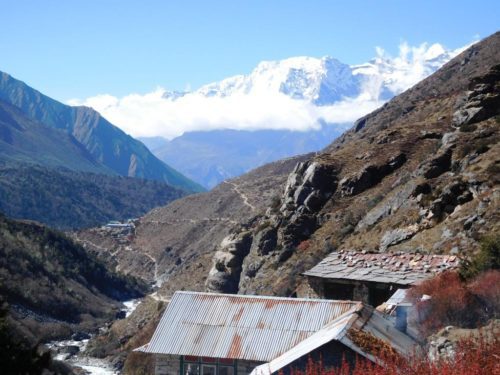
About half way looking back towards Pangboche.
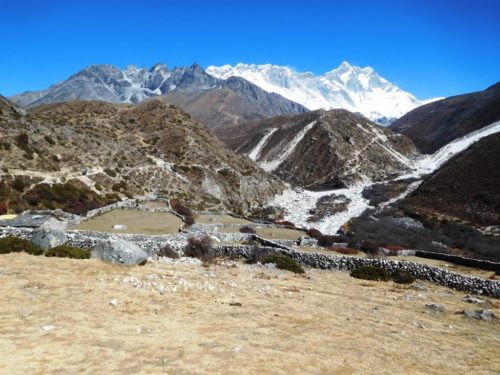
About half way looking towards Dingboche – could be out of a ‘spaghetti western’!
It is not until you see this that you are aware that the mountains are a vast crystalline growth on a truly gigantic scale. Of course you knew this intellectually all along: it is what the clash of continental plates and the uplift of crustal magma which creates them is all about, but not until you see the monstrous facets of stone mountains fissuring and fracturing away onto valley floors thousands of feet below are you truly aware that this is the same process yous see in your salt shaker or on your battery terminals at home but on a garagantuan scale.

Tsola River: Turnoff to Pheriche.
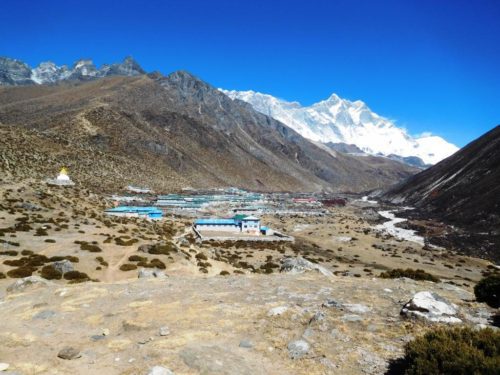
Dingboche: Nangachang Hill left
In Pangboche/Dingboche you are right below the Western slopes of Ama Dablam where there were apparently intrepid souls making their best efforts to commit suicide trying to reach the top. It looked impossible to me! Maybe the other side. It is the most photogenic of mountains. Some such suicide victim was clearly being rescued by this chopper in the morning in Pangboche. I did not notice when I snapped the scene the really super, supermoon hovering in the sky above it – yet that was weeks before the ‘official supermoon’! They do things differently in Nepal!


To me Ama Dablam is forbidding.
We had an acclimatisation day in Dingboche 4410 metres during which we climbed Nangartschang Hill just behind the French bakery where we were staying to approx 5200 metres. BTW the bakery also have a small Pharmacy which can be very handy if you are beginning to feel some symptoms of altitude sickness &/or Khumbu cough (they stock both Diamox and antibiotics, for example – also throat lozenges which you will also probably need by now!) If you take ½ a Diamox twice per day this will help prevent the symptoms of altitude sickness, which if you begin to suffer from, you must immediately descend – as it can be fatal! You should have begun this prevention strategy before you left Kathmandu (or Jiri).
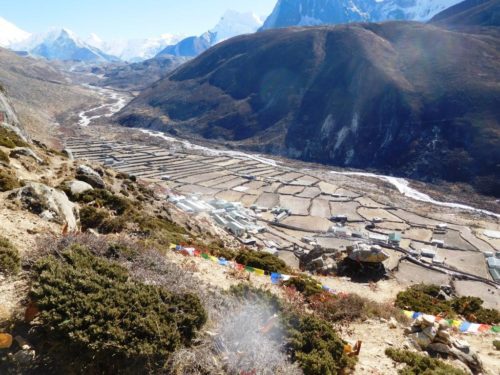
View of Dingboche from Nangartschang Hill: all the tiny brave potato fields.
Literally hundreds of folk were attempting the ascent of Nangartschang Hill as I set out after breakfast (Steve had preceded me – the young are always rushing ahead or lagging behind – why is it so?) Most turned back before the summit. When I arrived there I had only three others for company, including Steve. It was definitely a photo opportunity, but I must say I prefer greenery!

The Ultralight Hiker on top of Nangartscang Hill @ 5200 metres.
My head cold and sore throat became worse over the next 24 hours. I also felt very tired after the descent so reasoned that the planned foray to Chukkung Ri and the Kongma La Pass were not for me. I decided I would go on to Luboche and meet up with Steve at Gorek Shep. He would take my sat phone and I would take the sat messenger. I offered him the Escape Bivi but he still would not take it. The young. How they ever get to be old is a mystery – well, many of them don’t!
We parted just after breakfast and I headed off towards Luboche. However, I had to climb a couple of hundred metres over the hill I had climbed to the top of the day before with relative ease and after a while I could tell I was not going to make it. I could not tell whether it was altitude sickness or an onset of pneumonia at that stage, but I needed to get downhill immediately whichever it was and get well, so I headed off back towards Namche instead. I had a terrible two day walk there and on to Lukla as I described elsewhere, then a long, tortuous month recovering from the pneumonia which also struck young Steve down a couple of days later. I will let him carry on with his story of venturing on to Everest Base Camp:

Views (above and below) up the valley from Nangartschang Hill towards Chukkung.
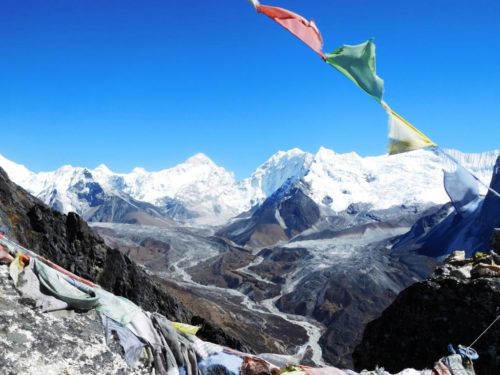
‘I left Dingboche early (after saying goodbye to Steve J) and didn’t leave Chukkung until just before noon. I made it to the false summit of Chukkung Ri at 2 pm at 5,404 meters (17,725 feet). My lungs were feeling surprisingly strong. The views were unbelievable. You could even see the iconic Pumori in the distance to the north.
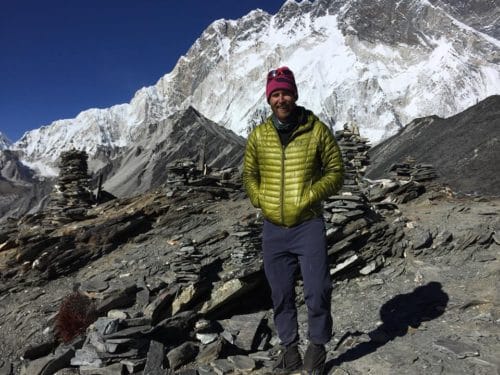
Steve H atop Chukkung Ri
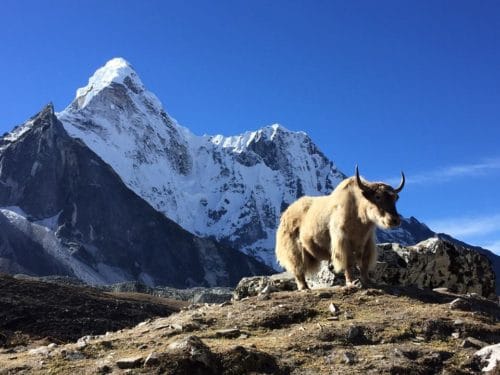
And a friend!
When I realized that the actual summit was further up, I pushed on, but it was already quite late. The route was rather difficult as I was climbing across loose rock on a ledge that dropped several hundred meters. Very close to the top, I even became bluffed out and had to turn back around to find the correct route marked by small cairns. I reached the summit at 4 pm, which is rather late for Himalayan standards, as I still had a very long descent.
From the summit, I could see that clouds were rolling into the valley and began whipping up and over the saddle, from which I would descend. So, I did not stay long. The descent took forever. It was late in the evening and the sun began to set, casting its beautiful golden light on the high peaks to the east. I took a lot of pictures of this evening magic, which is why I didn’t arrive back in Chukkung until a long while past darkness.
I’ve done some crazy hikes before, but the next day was definitely the hardest hiking day of my life. It’s one thing to hike above 18,000 feet and another thing to do it with a 30 lb backpack. I’ve now had two consecutive days above 18k feet – higher than the altitude of Everest Base Camp.

It was freezing this morning when we left Chukkung and we had a few initial problems crossing the icy, glacial-fed stream, as the ‘local’ advice was completely inaccurate. We eventually headed upstream and found a makeshift bridge to cross.
Once on the true right, we traversed the Nuptse Glacier and picked up the unmarked Kongma La Pass trail…Hiking further, a beautiful bowl opened up with frozen waterfalls and glacial peaks looming high as a backdrop. Even a massive condor or eagle with a wingspan of some six feet soared above us.
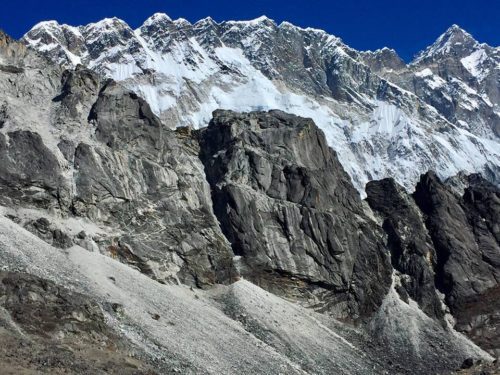
Once we turned the corner, it became clear that we had to climb straight up. With my pack fully loaded, I could only manage climbing five meters at a time before I had to catch my breath. The secret is to keep your heart beat as low as possible and just move slowly in a zombie-like fashion with one foot in front of the other…
Upon reaching a plateau, I passed these beautiful frozen lakes before climbing again to the main plateau en route to the pass. On the main plateau, I was starting to feel a bit sick. Not overly nauseous, but just enough to make me unsteady. The weight of my backpack was really holding me back, but I knew that I had to push on.
Walking further on the plateau, I could see the pass and the prayer flags in the distance. All of a sudden, a beautiful turquoise lake opened up out of nowhere, so I took the opportunity to rest and to munch on two Snickers bars.
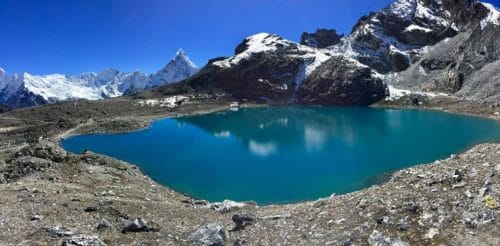
Eventually, I jumped back on the path again and began the final ascent to the pass. It was very steep with a huge drop down to the lake. There was so much sediment on the ground that it was very difficult to have much traction. A hiker from New Zealand coming down slipped and almost went over the edge. Finally, I made it to the pass at 5,535 meters (18,159 feet) feeling absolutely shattered. My body was completely spent. Fortunately, the views were just incredible.
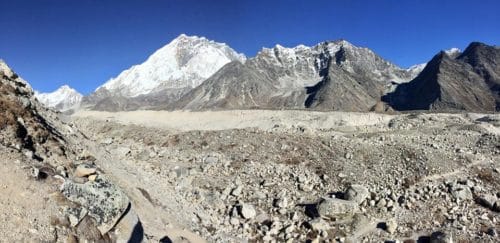
On the back side, the route descended through huge boulders before giving way to loose scree. It was a tough descent after already reaching exhaustion at the pass. After descending for well over an hour, I reached the bottom of the valley. The moraine from the Khumbu Glacier was just massive. Traversing it for roughly 1.5 km was slow going, as the rocks were loose and the route was not well defined. I was utterly exhausted, but had to push beyond my limits again in order to concentrate and avert injury.
Finally, I reached the other side. Turning around, I stood in awe at what I had just descended and traversed. The size of the Khumbu Glacier was just unreal. I then proceeded to descend into the village of Lobuche, where I stumbled around looking for a room. Eventually I found a dark and dingy tea house where I could rest my head. I changed my clothing and immediately passed out.
(Aside, Steve Jones: It was a good thing for me that I decided not to accompany Steve Ho on this climb, as what nearly defeated him would certainly have beaten me)
Next day I made it to Everest Base Camp (and also climbed Kala Pattar). Normally, people hike from Lobuche and do this itinerary in 2-3 days. I’m feeling pretty good. It is the third day in a row above 18,000 feet. Everything is literally freezing up here so I cannot write much of a message. For now, here are some pictures. Everest is absolutely beautiful…
Just a bit of an additional update. Yesterday was an amazing, but it is very, very cold to sleep up here at 17,000 feet. It was less than 5 degree F weather overnight here in Gorakshep. My Nalgene froze within 15 minutes. I could barely sleep due to the extreme cold and could definitely feel the altitude after such a long day. Throughout the night, you could hear huge chunks of glaciers careening off the mountains, creating a rumble that also keeps you awake…
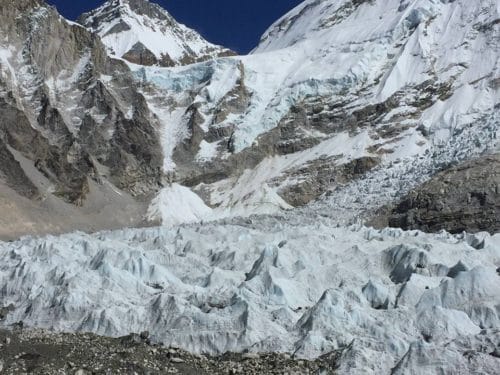
Khumbu Glacier.
I can’t believe just how many people are doing the EBC trek, which is precisely why I elected to do the much less trodden and much more challenging Three Passes Trek. From Lobuche to Gorakshep, I was literally running past groups just so that I could reserve a room in Gorakshep. Almost everything was booked out, but fortunately, the Snow Land lodge had one more room available…
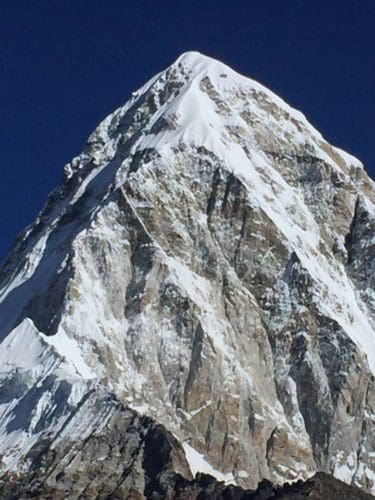
Upon reaching Everest Base Camp…You could only see a small section of Everest, but the real view was of Nuptse, the Khumbu Glacier and the infamous Khumbu Icefall. It was crazy to think that I was only one kilometer from Tibet…
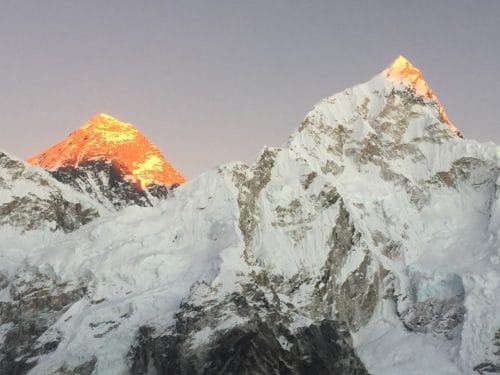
Once we headed back to Gorakshep, I grabbed a plate of spaghetti and then began climbing Kala Pattar…I kept pushing on to 5,465 meters. The sun was beginning to set, so I stopped and began to watch one of the most amazing sunsets of my life. The view of Everest was clear as crystal, with Chomolungma nestled between Nuptse and another unnamed peak…How could you not be spiritual in that moment. It really was an incredible sight.
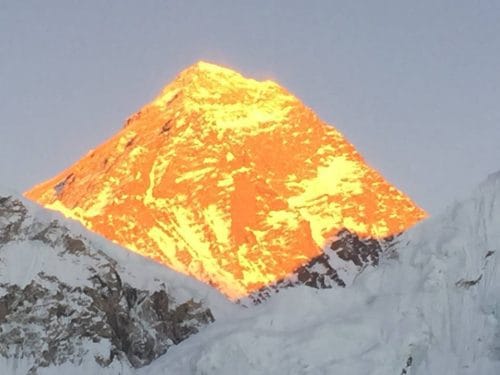
Even long after the sun had gone over the horizon and was no longer shining brilliant gold on these majestic peaks, these mountains remained as white as ever. The glow of orange and red and pink behind these mountains was also stunning…I then descended for the next 45 minutes using the moon glow to find my way back down. It was freezing. Every other person had his/her headlamp out, but I’ve done enough night hiking in my life to see and know the path…
Today, I am hiking all the way to Dzongla, which is supposed to be the most beautiful mountain town in Sagarmatha. I’m still batting a lump in my throat (due to a combination of cold and exhaustion), so I may spend an additional night there in order to recharge my batteries for the very challenging Cho La Pass…

So, I’ve arrived in Dzongla with a rather nasty throat cold. While hiking, the wind has, at times, been ferocious and, while sleeping, the air temperature has been averaging 5-10 degrees F. In the morning, I always find my window frozen with ice crystals due to the moisture coming from my exhalation. It is so cold in the lodges that the bathrooms are always frozen over with urine and faeces, presenting a not-so-appetizing trip to the loo. How people are able to avoid water-borne illnesses is beyond me. Mix in the Khumbu dust or cow dung smoke that you are constantly breathing in, and you have the perfect recipe to get sick. Tea houses are generally filled with a cacophony of coughs, of which I am now a contributor…
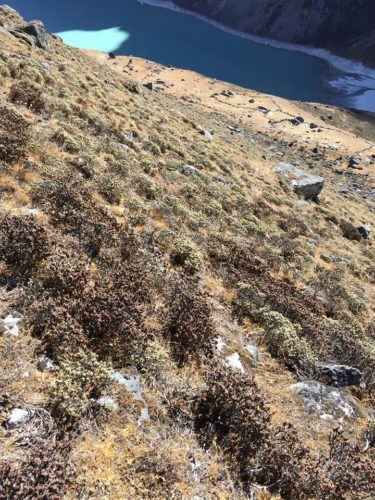
Walking from Gorakshep to Lobuche, I was really moving quickly. Unfortunately, due to my cold, the second portion of the hike to Dzongla really wore me down. I was very, very tired and struggled to put one foot in front of the other…my throat is completely swollen, which restricts my breathing – not a great attribute to have at 16,000 feet. My nose has constantly been running and it is very apparent that I must take a ‘zero’ day tomorrow so that I can rest. I need to be very fit to make it up and over Cho La Pass, so I’ll have to make a decision on my fitness tomorrow night.
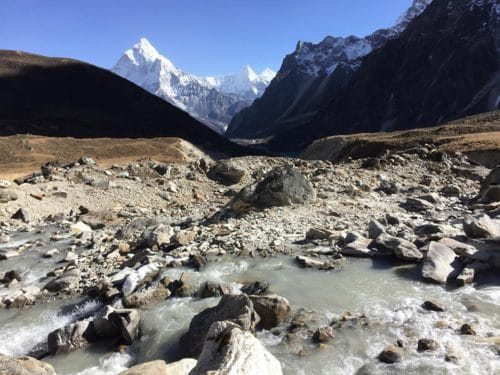
My eyes keep crying…my throat still hurts, and I have fluid constantly dripping from my nose. I’ve already gone through two rolls of toilet paper and that’s just from blowing my nose 🙂 Last night, my throat and lungs were so constricted that I could barely breathe in the thin air. Hopefully, tonight will be more bearable…
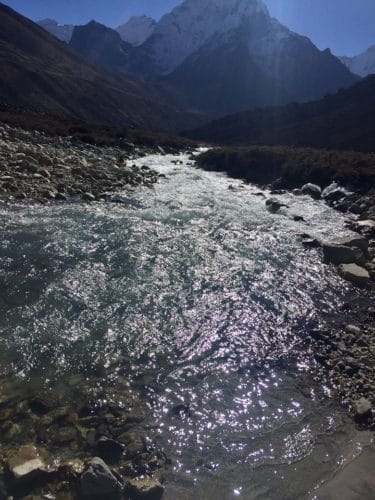
For all of these reasons, I have decided to throw in the towel and descend to Namche tomorrow.’
See also:
http://www.theultralighthiker.com/to-the-roof-of-the-world/
http://www.theultralighthiker.com/i-followed-my-footsteps/
http://www.theultralighthiker.com/i-saw-below-me-that-golden-valley/
http://www.theultralighthiker.com/thatendlessskyway/
http://www.theultralighthiker.com/the-diamond-desert-everest-base-camp-trek-8/
http://www.theultralighthiker.com/everest-base-camp-three-passes-trek/
http://www.theultralighthiker.com/cold-weather-face-masks/
http://www.theultralighthiker.com/my-life-was-wide-and-wild-and-who-can-know-my-heart/

